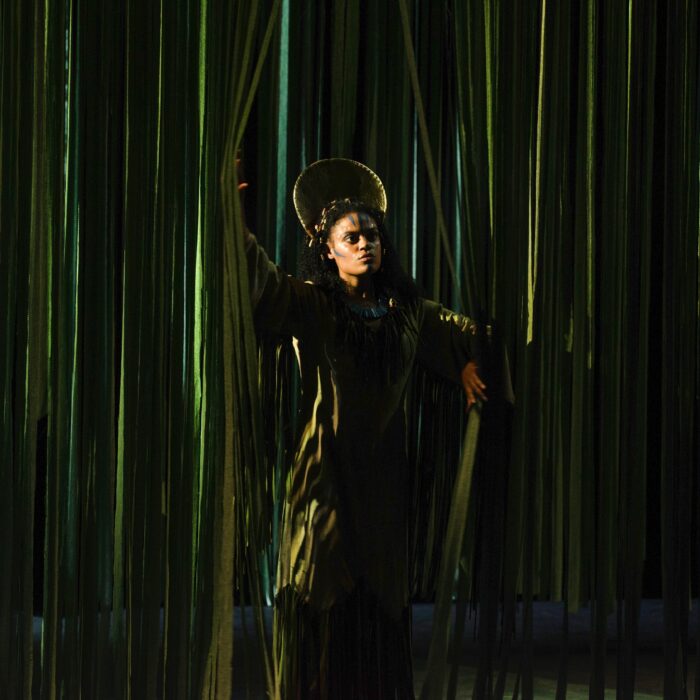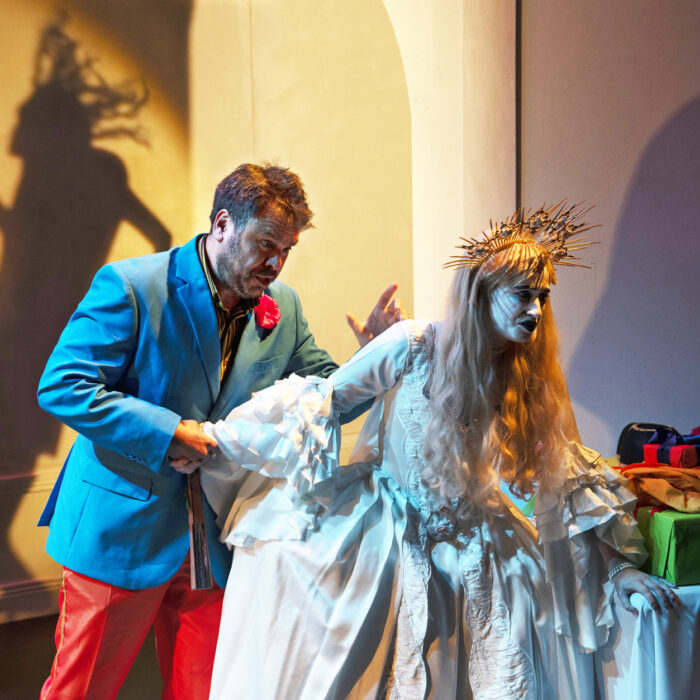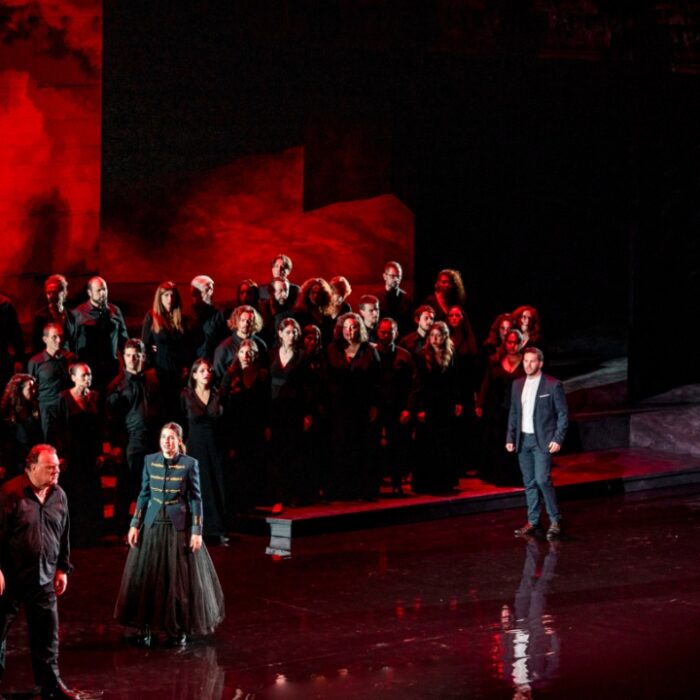
Glyndebourne Festival Opera Review 2025: Le Nozze di Figaro
Mariame Clément’s Second Installment of the Da Ponte Trilogy Is Full of Riches
By Benjamin Poore(© Glyndebourne Productions Ltd. Photography by Richard Hubert Smith)
By the time the current run of “Le nozze di Figaro” is concluded, Glyndebourne will have hosted its 600th performance of Mozart and Da Ponte’s perennial masterpiece. The opera launched the country house enterprise in 1934 at the behest of Fritz Busch and Rudolf Bing, who wisely cautioned against Christie’s Wagner-shaped Bayreuth-sized ambitions. It’s not hard to grasp why it has such a hold on the place – the fragrant summer gardens and the air of celebration among the well-to-do patrons providing a fine, ironic mirror for its action. One can only hope domestic discontent isn’t as widespread during the long interval as it is when the lights go down, but it’s a fine game to play.
Production Details
Mariame Clément’s new production has special significance then. It follows her “Don Giovanni” in 2023 – a complex and dark-hued riff on Fellini’s “La città delle donne” that received tepid reviews – and, I hear on the grapevine, anticipates a new “Così fan tutte” in coming seasons, completing the Da Ponte trilogy for a new generation of picnickers. It is also, as it happens, the first opera Clément has ever mounted twice (she previously produced it for Theater Dortmund in 2013). Riccardo Minasi, who has created scintillating recordings of Mozart’s work with Ensemble Resonanz, returns to the pit with Festival stalwarts the Orchestra of the Age of Enlightenment.
Clément’s production is a much more straightforward affair than her “Don Giovanni” in its conception and presentation, though the design and execution are rich with nuance, insight, and touches of deft originality. Julia Hansen’s revolve spins the public and private agonies of the piece through sets of doors and lurking servants, an unsettled world that suggests “La Folle Journée” but also recalls Beaumarchais’ background as a watchmaker – a technically demanding (it went wrong on the opening night) dramatic masterstroke. This is brilliantly deployed in several scenes: as the Contessa makes her entrance in Act two, as the stage turns, she has a discrete briefing with Susanna, and as soon as the door is shut behind her, she breaks down before her first vocal entry. As a piece of staging, it is intensely true to the poise and rawness of Mozart’s music.
The pastel colours of the design – born from Louis Carrogis Carmontelle’s painting of Mozart, and the Rococo influences of Watteau et al., including a swing in the finale – offer a muted and naive canvas on which remarkable moments of violence and vulnerability are painted. It is deeply rooted in the eighteenth century, but reflects an incredibly sensitive reading of the comedies of manners of that period. The Count is a real brute, strangling the Contessa when she refuses to open the door to the closet. It is the darkest vision of that Act two sequence I have ever seen, and imposed a chill on the house on a 27 degree day. We feel the claustrophobic interior of the house for the first three acts, with ears and faces present behind a fuzzy window and the promise of the garden outside; the opening scene’s bedroom is designed to feel like a contingent, exposed corridor.
The fragility and enticement of bodies is a key line of thought. Figaro arrives in the Contessa’s room as she is getting changed; Act three begins – hilariously – with the Count hidden in a beautiful bathtub (the same used in Clément’s “Don Pasqaule” at Glyndebourne, I wondered), ruminating on private thoughts as his servants dress him. Don Basilio is played with a Hogarthian hunch to compelling, ugly effect; Marzellina’s various monies and legal papers come from reaching under her skirts with a naughty exposure of legs. By contrast, the Contessa is a physical cipher, hidden under a huge dress of remarkable beauty, physically isolating her.
Stage Direction & Musical Highlights
The most striking directorial intervention is the creation of a silent daughter (played with exquisite grace by Pippa Barton) for the Count and Contessa, who becomes a tragic cipher for the Contessa’s deep alienation from not just her marriage but her whole being. She is met by the Contessa in passing, and whisked away, sadly, at the climax of ‘Dove sono;’ an especially fine moment of Personregie is the Count popping in to play with her, a perfect doting father, before passing across the stage with a swift but lewd glance at the young nanny attending the scene. It captures the uncanny blend of lithe charm and sexual opportunism that he is, refracted in parts by Barbarina and Cherubino, who may or may not be younger libidinal echoes of him. Inside this, there is a sad distance between the Countess and her daughter – the hints of a real family tragedy that I have not seen before in this opera. Cherubino is given some smart touches – an a capella out-of-tune beginning to ‘Voi, che sapete’, shy and wounded – though there wasn’t enough playfulness and eroticism – so crucial with Susanna and the Countess – for my money. Figaro himself was something of a dummy throughout, and needs Susanna’s help, pulled off with plenty of humour, and Clément has a real genius for giving singers – not always the best actors – something fun to do with their hands which might otherwise stifle things. Happily, it’s a production that foregrounds the women of the show, and has a psychological precision in what looks, on the surface, like a period production, and sneaks in a modernist intensity.
This being said, the conclusion of the opera didn’t satisfy or antagonize enough in either direction. The Contessa does some will-she-won’t-she back-and-forth with the Count – an emotional high point that felt fudged, even if the Count is abandoned, broken, in the very final bars – it felt like her daughter should’ve returned to offer some dramaturgical definition and sweeten the deal. When the revolve disappears for Act four, the piece gets a little stiff and the entire stage picture flattened like the prop bushes, which nearly went awry (saved in the moment with professional grace by Basilio). The entire Act four set lacked the dynamism that we’d enjoyed so far, and the key interjections from hidden characters felt occluded, draining energy from the stage with a more dour lighting plot.
Minasi is a fascinating conductor and genuinely finds things I’ve never heard before in the score, even and especially when I don’t agree with them. It was signalled in the Overture with a couple of surprising ritenuto and continued throughout. A flexible approach to tempo – exemplified in a sculpted ‘Non più andrai’ – felt like an attempt to show us Mozart’s organic musical dramaturgy, with the word setting full of light and shade, and mostly succeeded, with plenty of sequences feeling like the score was box fresh.
This approach to Mozart has been utterly compelling in his accounts of the symphonies with Ensemble Resonanz – I recall a fabulous concert at the 2024 Proms and a brilliant album – but at times felt fussy in this production, with some mystifying tempo choices in the Act two finale. ‘Esci ormai, garzon malnato’ was in a sluggish two, with none of the Count’s urgency in what felt like a rehearsal tempo; likewise the subsequent ‘Susanna, son morta…’ trio felt cautious, in a keen four rather than giddy two, robbing the women of their elated curiosity when it turns out they’ve got away with it. Despite these laid back moments, not enough time was taken – dramatically or musically – in one of the greatest moments in the opera – the silent bar that follows Rosina’s retort in that same trio that he shouldn’t call her that any longer, before a sudden disconcerting shift into A-flat major.
I quibble these details only because it was otherwise a sensational account of the score from the OAE and Minasi, with quick transitions between scenes and fizzy, ingenious continuo work from Matthew Fletcher and Luise Buchberger – as well as a very funny whistled interpolation of ‘Fin ch’han dal vino’ from the drunk Cherubino in Act four – a portent of his future, perhaps. Praise should be reserved for the natural horns and woodwinds on such a hot day – even in normal circumstances it’s the musical equivalent of lion-taming, and one of the bassoonists even found time on the train back to play the opening passage from the overture.
Stellar Cast
The cast was in stellar form and only space forces brevity. Louise Alder, a singer who has earned her spurs on the continent, sang one of the most perfectly balanced Contessas I have heard in years – even across the entire range, fresh and vigorous when seeing the truth of her situation, and an utterly compelling actor. In ‘Dove sono’ we heard rich, inward dignity, and moments of sublime privacy, with no indulgence or heaviness. Her response to the Count’s plea for forgiveness had a glassy fragility that was deeply moving. The technical demands of the role were water off a duck’s back. Her counterpart in Susanna – Johanna Wallroth – was gleaming and energetic, with a strong sound and a true legato that got its proper spotlight in ‘Deh, vieni, non tardar’ and the ‘Sull’aria’ duet – the voices providing an intimacy lacking in the direction there. It’s a relentless, thankless role – Susanna is never actually alone onstage – and Wallroth sparkled.
Michael Nagl’s Figaro was full of vocal charm, showing off a host of colours in ‘Se vuol ballare’ and ‘Non più andrai’, and a fine, silky sotto voce; it’s a voice that whips through recitative with vim and vigour and a substantial quality matched to Clément’s direction of this silly charmer. Huw Montague Rendall’s Count was a real baritonal tour-de-force, the top F-sharp in his Act three aria dispatched with elan and swooping down without a breath to its conclusive phrase – very classy.
There are no bit parts in “Figaro”, but: Ru Charlesworth sang an eerie Basilio, giving an astonishing physical performance. The master of patter Alessandro Corbelli gave a sympathetic Bartolo, with machine-gun precision in his Act one aria. A one-armed Antonio – a hint of the horrors of life in the Count’s regiment, perhaps? – in the shape of Alexander Vassiliev was delightfully rough. Adèle Charvet’s Cherubino was in luxurious voice, balancing sensuality with friskiness, and seducing the entire auditorium in a smouldering ‘Non so più cosa son.’ I wonder if she could be a bit more naughty in the revival.
A careless viewing of this production will see it as safe and bankable – business as usual at the ur-picnic table of the country house opera industry in the UK. It’s vastly better than that, and the pretenders to the Glyndebourne throne should take note. I would welcome some more risks from Clément in this show, perhaps, and a sharper dramaturgical blade – but this is a staging made from subtlety, imagination, and directorial care – it will run and run.


